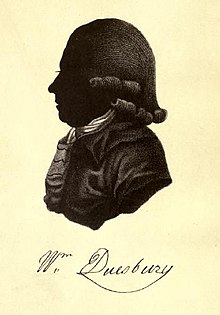William Duesbury
William Duesbury | |
|---|---|
 Silhouette of William Duesbury (18th century). | |
| Born | William Duesbury September 7, 1725 Longton Hall, Staffordshire, England |
| Died | 30 October 1786 (aged 61)[1] |
| Nationality | English |
| Citizenship | British |
| Occupation(s) | Enamelist, entrepreneur |
| Spouse | Sarah James |
| Children | William Duesbury II |
William Duesbury (1725 - 1786) was an important enameller and British entrepreneur from the 18th century, founder of the Royal Crown Derby and owner of porcelain factories at Bow, Chelsea, Derby and Longton Hall.[2]
Biography

Duesbury was born on September 7, 1725.[2] Around 1742 he was working as an enameller in London, where he remained until 1753. Subsequently, between 1754-5, he lived and worked in Longton Hall, where his father dwelled. In 1756, having accumulated some money, and after become acquainted with the leading manufacturers of china and its products, he decided to found a porcelain factory in Derby, at Nottingham Road. In this project, he was funded by John and Christopher Heath, local bankers,[3] and aided with the expertise of André Planchè, a potter living in the city.
In 1775 Duesbury and John Heath were recorded the honour being given a Royal Warrant by George III by including a crown on their porcelain mark. The Duesbury "D" was now capped with a crown to record that they were 'Derby China Manufacturers to His Majesty'.[4]
After the failure of the Heaths, he took over the business. He died in November 1786, and was succeeded by his son, William Duesbury II.[5]
References
- ^ Campbell, Gordon (2006). The Grove encyclopedia of decorative arts. New York: Gordon Campbell. p. 334.
{{cite book}}: Cite has empty unknown parameter:|coauthors=(help) - ^ a b William Page, ed. (1911). "Pottery: Chelsea porcelain". A History of the County of Middlesex. Vol. 2: General, Ashford, East Bedfont with Hatton, Feltham, Hampton with Hampton Wick, Hanworth, Laleham, Littleton. pp. 150–155. Retrieved 2011-07-31.
- ^ Bemrose, William (1898). Bow, Chelsea, and Derby Porcelain. London: Bemrose & Sons, Ltd. p. 6.
{{cite book}}: Cite has empty unknown parameter:|coauthors=(help) - ^ "History of Royal Crown Porcelain Company". History of UK Potters and Potteries 1900-2010. Retrieved 2010-07-31.
- ^ "Royal Crown Derby". Antique Marks. Retrieved 2011-07-31.
